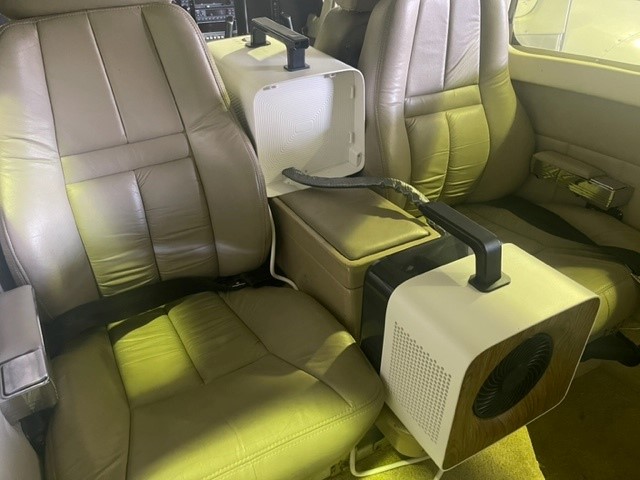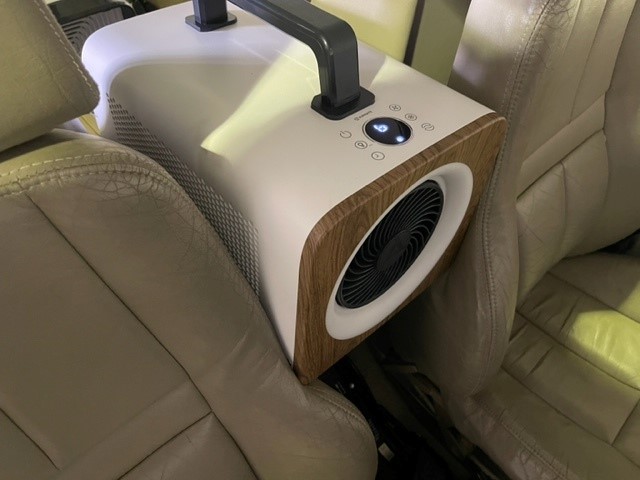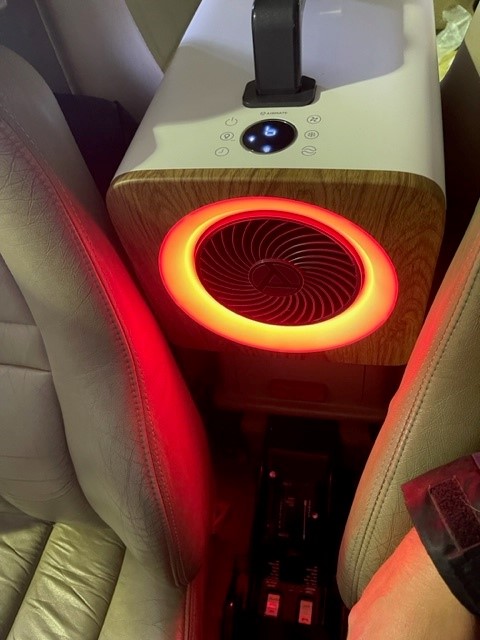Options for cabin cooling
I have tried many paths over the years for air conditioning in the cabin including owning planes with factory AC.
1) Ice based systems work as long as you have the space and the ice. 1800 BTU/hr = 12 lbs of ice per hr. This is enough to cool a small area only. Most car AC systems are 12,000 BTU and this would require 83 lbs of ice per hr...
2) Fan systems in most planes are no effective. Supplemental 12V and 18V fans can make a difference - although this is circulating hot air...
3) 12V retrofit systems for certified planes are usually a compromise and may not be fully legal. The big issues are where to dump the heat and how to power. Most planes do not have the power with stock alternators to keep ground cooling for long.
4) 12V Experimental aircraft AC's work well provided the electrical system is up to snuff. These generally use a belt powered compressor. The best systems have an under fuselage condenser that looks like a P51 scoop.
5) Ice circulating cooling jackets seem promising. I have not tried this path yet. https://www.pegasusautoracing.com/group.asp?GroupID=COOLSHIRT
6) Here is another option - the Airmate MAC509. I am not sure if it is still available but I did receive one. https://www.indiegogo.com/projects/airmate-outdoor-split-ac-fast-cooling-your-trip#/
I power this with a hefty 120V AC lithium battery bank so it is independent of the aircraft battery and you can run it pre-start. It puts out 1800 BTU at the highest speed and uses ~ 600W or so. It is a tiny mini split system so you are cooling the front of the cabin at the expense of the back. I hope to do more testing this summer but promising so far.
The key is it fits far enough forward that the air is direct to the cockpit and the short split segment gets the heat far enough aft.
Here are some pics of a trial fit (not strapped in). There is also a small condensate drain not shown. It also has a light and it is really designed for tent camping at a drive in campsite where you can have the evaporator in the tent and the condenser outside.
This cools the front of the plane at the expense of the aft. In flight the extra heat goes out the exhaust and the cooled air lingers long enough to make a difference in the cockpit. I use an 1100 Whr power station so enough for about 2 hrs at full blast.
As it is finally starting to warm up here I will have more to report soon.
Eric Panning
1981 Seneca III
Hillsboro, OR (KHIO)




Comments
Good write-up!
All of the items for consideration rely on active work, what about passive?
Seems that a good approach to cooling is avoiding heat generation. Have read enough commentary from the automotive community regarding heat shedding films to recognize that window coatings have benefits for minimizing heat generation. Less heat to start with turns into downsizing the cooling requirements.
Anybody with window tinting have either measurable or anecdotal results to share regarding heat mitigation?
Thanks Eric! Great post :)
Scott Sherer
Wright Brothers Master Pilot, FAA Commercial Pilot
Yes, there are companies working on white paints that reflect 98-99% of incident light and also convey IR so effectively they can radiate away interior heat. As you pointed out there are also window films for planes that reject heat. I have no experience with either but these could be good solutions alone or in combination. I think the white paint is still in the research phase but many window films available now.
Some more unusual ideas for cooling:
Liquid Nitrogen:
Dry ice has about the same concerns as well as forming a weak acid with water. It is 246 BTU/lb vs 144/lb for ice so that is a plus.
Condenser system using fuel vs air to cool the refrigerant. You could have a system that has a circulation loop pulling fuel from a tank, using the fuel to cool the refrigerant (gas to liquid) and then put the fuel back into the tank. This would be a very interesting no drag system for experimental planes. I don't think you would ever get something like this approved for certified GA planes. Marine systems work like this except they pull water from lake/ocean for the cooling.
This one is 12A at 12V and the flow rate is 1.75 gpm for 5000 BTU. So, for a 30 gallon tank you would be cycling the tank every 17 minutes... https://archerpowersolutions.com/products/kingfisher-ma37x12b-marine-air-conditioner
Here is another portable cooler that is similar to the mini-split system I included pictures of. In this case you would route the hot air to the baggage area/rear cabin. I might get this one too to play around with it ;) It is 30 lbs.
There are also a bunch of 12V mini-split systems designed to cool a truck cabin. The challenge is powering them and where to exhaust the heat.... On a Seneca twin you could put the condenser in the tail and hook up the evaporator outlets to the overhead air vents. Good luck on the approvals! ;)
Eric Panning
1981 Seneca III
Hillsboro, OR (KHIO)
While going down the creative alternatives path, there is the closed ammonia system which marine and RV refers use.
One aspect I see as a weak link for any portable solution is condensation control. Not so much of an issue in the Phoenix or Denver areas, but Houston and Savannah can turn into another story. Sure, the portable A/C devices look like they have storage containers to capture condensation, but the open question is how well they manage water in either turbulence or during the takeoff / landing cycles. Only one way to find out though 😁
If the plane is sitting out in the elements, all the more reason to focus on passive heat rejection as a first defense. Less hot to start means quicker to cool.
3M looks like it is trailblazing with its Crystalline film series and impressive heat rejection numbers. Bonus is notation that this film does not interfere with EM.
Only possible downside to film coating the windows is whether they are within range of needing replacement. If so, best to replace the windows as part of the coating project rather than coating now, and again in a few years with window replacement.
When parking outside I use a set of covers from Bruce's (with the white side facing outward) for the forward windscreen and cockpit windows, and the OE shades for the remaining windows. This combination does a respectable job at mitigating heat soak. Have not measured cabin vs ambient temperatures on a hot sunny day, but anecdotally I do not get a blast of hot air when first opening the doors like I do with the car. Reason for placing the covers with white side facing outward is that the silver side actually absorbs heat and will create a hot zone between the cover and window even though the cabin interior seems cooler than without the cover.
Hi,
I did order this one:
Looks like it will be fun to try. Claims it uses the condensed water to cool the condenser so no water trap needed. We shall see!
Eric Panning
1981 Seneca III
Hillsboro, OR (KHIO)
I live in Corpus Christi and when I take somebody flying in the summer they ask if my airplane has air conditioning. I tell them yes, it works great at 8,000 feet!
John O’Leary
Turbo Arrow IV (KRKP)
CFI CFII CFIMEI (Gold Seal), ATP(MEL)
Wright Bros. Master Pilot
I tried this one out now that it is hot out. I can easily power it with a portable 1kWhr power supply and it draws about 700 watts. However, if the heat is just exhausted out back to the aft cabin it makes it way back to the front and the net effect is cooling does not last long. I think it would work ok if the heat was exhausted direct into the tail cone via a modified access panel - you would be dumping about 1 kW of heat into there... I have not tried this. The other downside is the the heat exhaust line is long if you want the cool air up front so it acts like a mini radiator....
Eric Panning
1981 Seneca III
Hillsboro, OR (KHIO)
Wow - 700 watts? That's 58 amps on a 12 volt system at 100% efficiency. I know my PlanePower alternator won't keep up with that, and the everyday load.
Are you sure this is viable in an aircraft?
Are you using a portable Li-Ion power pack to power that thing?
VFRs,
Yes, i am using a 1kWhr Lithium power pack that can supply 1000watts (for 1 hr). The AC is also capable of being powered with DC direct too. My twin could technically source this much above idle on both engines. I am just playing around at the moment so the power pack is fine. using the [power pack also allows for ground cooling too.
Eric Panning
1981 Seneca III
Hillsboro, OR (KHIO)
Hi All,
This has been working for me over the past handful of summers that I’ve owned the airplane.
The Arctic Air Ice Cooler…
This all works guys and gals, just takes a little effort…but I think it’s worth it help keep your Pax and yourself a bit more comfortable.
OR, you can just go out and buy ya a $1 Million Mailbu, like I shoulda done! 😜 …you’ll save $ on ice!
Hope that helps a little bit!
Stay Cool, Fly Fun
George
N8434M KLPR